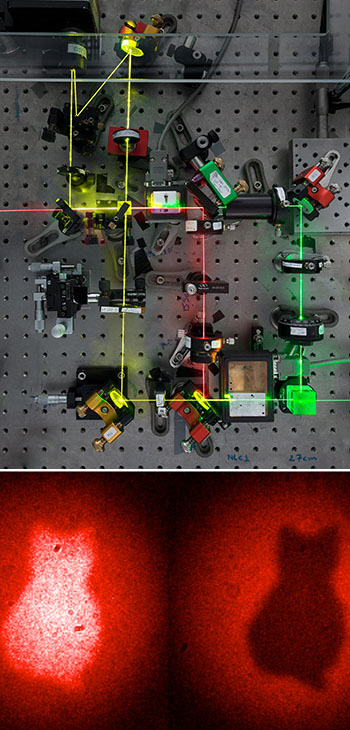
Top: Experimental setup, with original laser source in green, idler beam in red, and signal beam in yellow (credit: Lois Lammerhuber). Bottom: Intensity imaging of a simple cat cutout using the method (credit: Patricia Enigl, IQOQI).
Quantum weirdness—famously described by Einstein as “spooky action at a distance”—can now rack up another accomplishment: A team in Vienna has developed a technique to image an object using entangled photons that have never actually interacted with it (Nature, doi: 10.1038/nature13586). The technique, described as “fundamentally new,” could find particular use in certain difficult, low-light imaging situations, including biological and medical imaging, according to the scientists.
Imaging techniques generally involve detecting light that has been either scattered from or transmitted through the object being imaged. To investigate an alternative approach, Gabriela Barreto Lemos and colleagues at the Austrian Academy of Sciences and the University of Vienna used a setup in which the beam from a single 532 nm pump laser is split and sent on different paths through two nonlinear down-conversion crystals. Each crystal creates paired photons—a 1,550 nm “idler” photon and an 810 nm “signal” photon, respectively—and the idler photon from the first crystal, routed by a dichroic mirror, is passed through the object being imaged.
This stream of idler photons is then overlapped with the idler amplitude coming out of the second nonlinear crystal along a separate path, and the combined idler photons are routed out of the imaging system with another dichroic mirror. The idler photons, which have interacted with the object, are never actually detected. Instead, it is the interference of the amplitudes of the signal photons—which are entangled with the idler photons, but have never encountered the imaged object itself—from which the image is extracted.
One advantage of the new quantum approach, according to the team, is that the wavelength of the light that illuminates the object need not be the same as the light creating the image. That means that the probe wavelength can, in principle, be chosen even if detectors do not exist for it, since the signal can be read at a different wavelength—a factor that could prove quite useful for imaging in certain infrared bands at very low light.
